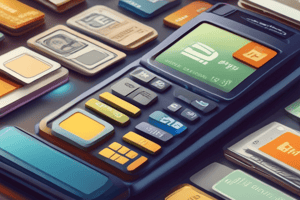Podcast
Questions and Answers
Apa keuntungan dari menggunakan uang tunai untuk pembelian kecil?
Apa keuntungan dari menggunakan uang tunai untuk pembelian kecil?
- Tidak mudah hilang atau dicuri.
- Cepat diakui sebagai dana yang tersedia. (correct)
- Memiliki kemampuan untuk melakukan transaksi global.
- Memiliki jejak untuk pelacakan transaksi.
Apa kekurangan dari menggunakan cek sebagai metode pembayaran?
Apa kekurangan dari menggunakan cek sebagai metode pembayaran?
- Cepat diakui sebagai dana yang tersedia.
- Dapat digunakan secara internasional tanpa kendala.
- Mengambil waktu lebih lama untuk di-clearing dibandingkan dengan opsi elektronik lainnya. (correct)
- Mudah dipantau dan dilacak.
Apa fungsi dari Venmo dan Zelle dalam industri pembayaran?
Apa fungsi dari Venmo dan Zelle dalam industri pembayaran?
- Menyimpan detail kartu kredit pengguna.
- Memberikan pinjaman online.
- Menawarkan kartu debit virtual.
- Memfasilitasi layanan transfer uang mobile antar orang. (correct)
Apa teknologi yang digunakan dalam dompet digital untuk melakukan pembelian tanpa kontak?
Apa teknologi yang digunakan dalam dompet digital untuk melakukan pembelian tanpa kontak?
Apa perbedaan utama antara pembayaran digital dan tradisional?
Apa perbedaan utama antara pembayaran digital dan tradisional?
Apa kelebihan menggunakan kartu debit dibandingkan dengan uang tunai?
Apa kelebihan menggunakan kartu debit dibandingkan dengan uang tunai?
Apa platform yang digunakan untuk memfasilitasi pembelian internet?
Apa platform yang digunakan untuk memfasilitasi pembelian internet?
Apa yang dilakukan oleh Point-of-Sale (POS) systems?
Apa yang dilakukan oleh Point-of-Sale (POS) systems?
Apa manfaat utama dari Electronic Fund Transfers (EFTs)?
Apa manfaat utama dari Electronic Fund Transfers (EFTs)?
Apa yang dibawa oleh teknologi Blockchain ke dalam dunia pembayaran?
Apa yang dibawa oleh teknologi Blockchain ke dalam dunia pembayaran?
Apa peran dari provider seperti Stripe, Braintree, dan PayPal dalam solusi e-commerce?
Apa peran dari provider seperti Stripe, Braintree, dan PayPal dalam solusi e-commerce?
Apa dampak dari perkembangan teknologi terhadap pemilihan metode pembayaran?
Apa dampak dari perkembangan teknologi terhadap pemilihan metode pembayaran?
Flashcards are hidden until you start studying
Study Notes
Exploring Payment Systems and Tools
Payment methods have evolved significantly since the first barter trades of ancient civilizations, leading us to today's seamless transactions with just a few taps on our devices. In this guide, we'll delve into different types of payment systems and popular tools used by consumers and businesses alike to handle financial exchanges securely and conveniently.
Traditional Payment Methods
Before exploring modern innovations, it helps to understand traditional systems such as cash, checks, debit cards, credit cards, and wire transfers. Each has its advantages and disadvantages regarding speed, security, convenience, costs, and global reach. For instance, cash remains widely accepted for small purchases, yet it lacks a trail for transaction tracking and can easily get lost or stolen. Checks guarantee funds upon approval, but they take longer to clear compared to other electronic options like digital payments.
Digital Wallets and Mobile Payments
Digital wallets, like Apple Pay and Google Pay, enable users to store their payment information (credit card details) within a smartphone app. These allow customers to make contactless purchases using near field communication (NFC) technology, simplifying transactions both online and offline. Additionally, companies such as Venmo and Zelle offer person-to-person mobile money transfer services.
E-Commerce Solutions
Electronic commerce solutions facilitate internet purchases through various platforms including websites, apps, and social media profiles. Popular players here include Stripe, Braintree, Authorize.net, Shopify Payments, Square, and PayPal. These providers process online orders efficiently, manage customer accounts, and accept multiple currencies and forms of payment.
Point-of-Sale Terminals
Point-of-sale terminals, also known as POS systems, remain prevalent in brick-and-mortar stores. These machines enable merchants to accept multiple payment methods, track sales data, issue refunds, and manage inventories. Examples of prominent POS systems include Vend, Lightspeed Retail, Clover Station, Toast, and QuickBooks POS.
Electronic Fund Transfers
Electronic fund transfers (EFTs), which cover direct debits, automated clearing house (ACH) transactions, and real-time payments, allow transactions between banks without physically moving paper currency. These methods benefit from reduced processing time and lower operational costs, yet may require more extensive regulatory compliance due to the sensitive nature of handling consumer bank account information.
Blockchain Applications
Blockchains bring cryptocurrency, NFTs, and decentralized finance (DeFi) applications into the realm of payments. Bitcoin is one of many cryptocurrencies allowing global transactions directly between parties without intermediaries. While these technologies still face some challenges, they present opportunities for faster international payments, lowered fees, and improved security measures via advanced encryption protocols.
Understanding the diverse array of payment systems and tools available enables individuals to select the best method tailored to their needs. As society continues evolving towards a digital future, increased innovation will undoubtedly bring forth new techniques and opportunities in the world of payment solutions.
Studying That Suits You
Use AI to generate personalized quizzes and flashcards to suit your learning preferences.




